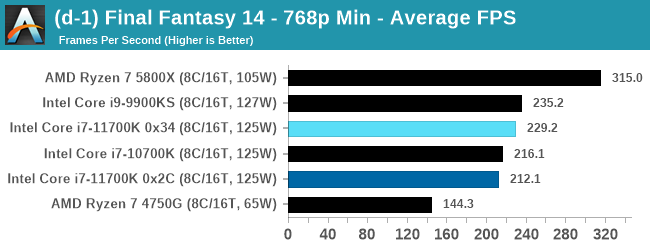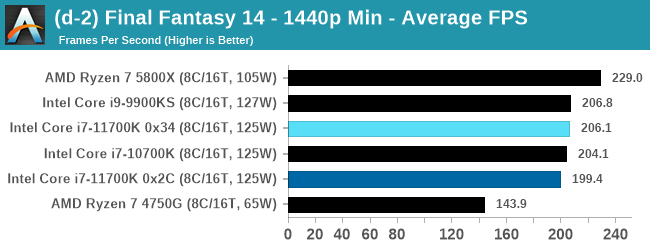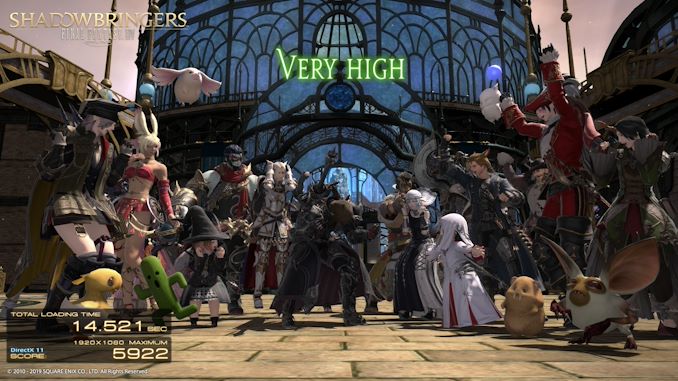Intel Core i7-11700K Review: Blasting Off with Rocket Lake
by Dr. Ian Cutress on March 5, 2021 4:30 PM EST- Posted in
- CPUs
- Intel
- 14nm
- Xe-LP
- Rocket Lake
- Cypress Cove
- i7-11700K
Gaming Tests: Final Fantasy XIV
Despite being one number less than Final Fantasy 15, because FF14 is a massively-multiplayer online title, there are always yearly update packages which give the opportunity for graphical updates too. In 2019, FFXIV launched its Shadowbringers expansion, and an official standalone benchmark was released at the same time for users to understand what level of performance they could expect. Much like the FF15 benchmark we’ve been using for a while, this test is a long 7-minute scene of simulated gameplay within the title. There are a number of interesting graphical features, and it certainly looks more like a 2019 title than a 2010 release, which is when FF14 first came out.
With this being a standalone benchmark, we do not have to worry about updates, and the idea for these sort of tests for end-users is to keep the code base consistent. For our testing suite, we are using the following settings:
- 768p Minimum, 1440p Minimum, 4K Minimum, 1080p Maximum
As with the other benchmarks, we do as many runs until 10 minutes per resolution/setting combination has passed, and then take averages. Realistically, because of the length of this test, this equates to two runs per setting.

| AnandTech | Low Resolution Low Quality |
Medium Resolution Low Quality |
High Resolution Low Quality |
Medium Resolution Max Quality |
| Average FPS |  |
 |
 |
 |
As the resolution increases, the 11900K seemed to get a better average frame rate, but with the quality increased, it falls back down again, coming behind the older Intel CPUs.
All of our benchmark results can also be found in our benchmark engine, Bench.











541 Comments
View All Comments
TheinsanegamerN - Monday, March 8, 2021 - link
They're the same chip, the only difference is clock speeds. Dont get your hopes up, RKL is a total dud, much like Williamette was.Samus - Saturday, March 6, 2021 - link
blppt - my concern is that AMD may have a superior IPC, but the real fruit comes from the manufacturing process. Intel is still (somewhat) competitive at 14nm and that in itself is quite unbelievable. Imagine where this chip would be on 7nm or 10nm, at 6GHz+ and more cores with 2-3x the cache.That said, this victory may be short lived because AMD is basically taking advantage of the embarrassing execution Intel has repeated, much like they did 20 years ago with the P4 (albeit that was an architecture failure, not a manufacturing process failure)
Thesubtlesnake - Saturday, March 6, 2021 - link
Intel's latest 10nm process delivers *slower* clocks than its 14nm one. So, no, 6 GHz is not on the table. I imagine that when the transition to 7nm, Intel will be able to achieve moderately faster clock speeds than with 14nm.Otritus - Sunday, March 14, 2021 - link
10nm SF is good enough for 5 GHz. 10nm ESF can clock higher, so Intel's latest (but unreleased) process should match 14nm. I would not expect 7nm to clock higher than 14nm because it is becoming very clear that 5Ghz+ is just a waste of power and transistors, so i would not expect 7nm architectures to be designed to clock higher. We either are getting lots of IPC or just over 5GHz.Slash3 - Friday, March 5, 2021 - link
Mad lad.edved - Friday, March 5, 2021 - link
Nice write-up. Thank you.lucasdclopes - Friday, March 5, 2021 - link
Power efficiency is abysmal on this one.CiccioB - Friday, March 5, 2021 - link
No, it is not. It lower than AMD's efficiency, but it not that bad for being based on such an old process.PixyMisa - Friday, March 5, 2021 - link
So it's abysmal, but that's only to be expected?Spunjji - Saturday, March 6, 2021 - link
Not bad for an old process is still abysmal by the standards of 2021. No wonder Apple dropped them like a hot rock.